Search -
Diane Arbus : An Aperture Monograph
Diane Arbus An Aperture Monograph
Diane Arbus-- born Diane Nemerov in New York City in 1923-- married Allan Arbus at the age of eighteen. She started taking pictures in the early 1940s and studied photography with Berenice Abbott in the late 1940s and with Alexey Brodovitch in the 1950s. It was Lisette Model's photographic workshops, however, that inspired her, around 195... more »
Diane Arbus-- born Diane Nemerov in New York City in 1923-- married Allan Arbus at the age of eighteen. She started taking pictures in the early 1940s and studied photography with Berenice Abbott in the late 1940s and with Alexey Brodovitch in the 1950s. It was Lisette Model's photographic workshops, however, that inspired her, around 195... more »
ISBN-13: 9780893816940
ISBN-10: 0893816949
Publication Date: 6/15/2005
Pages: 184
Rating: 1
ISBN-10: 0893816949
Publication Date: 6/15/2005
Pages: 184
Rating: 1
4.5 stars, based on 1 rating
Genres:
- Arts & Photography >> Photography & Video >> Photographers, A-Z >> General
- Arts & Photography >> Photography & Video >> Portraits




